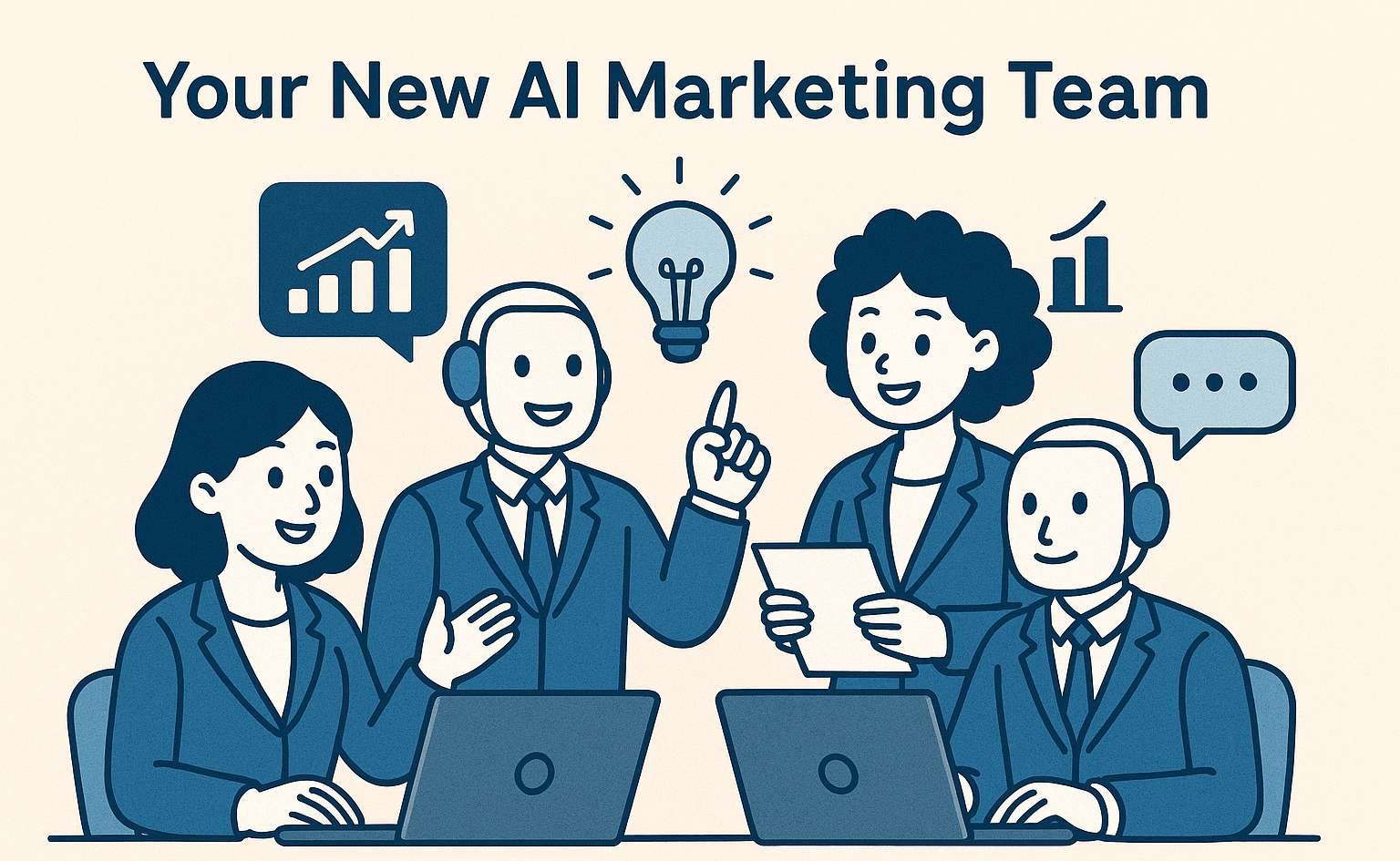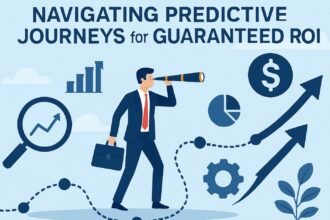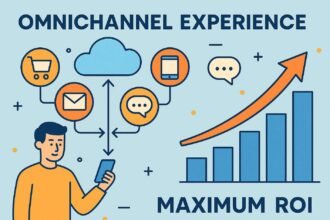Foundations of AI-Driven Marketing
Artificial Intelligence in Marketing refers to the application of advanced algorithms and data-driven approaches from AI and machine learning to drive business results, which is partly undertaken within Marketing—i.e., building marketing capabilities powered in part by AI. The best-optimized marketing capability draws from many such AI initiatives spanning Customer Life Cycle Management, Marketing Innovation Management, and Marketing-Economic Performance Management.
Understanding these AI applications in Marketing, how that capability is built and run, and why it delivers better results faster is crucial, as enterprises must rapidly learn what is possible and potentially get left behind. External pressures create demand for ever-more individualistic customer experiences that nurture retention at lower cost, while making best use of dwindling resources through automation. These capabilities can only realistically be delivered by AI-powered marketing. A virtual team of AI Marketing Program Managers specializing in the relevant business areas can navigate the risks of AI projects by having a high-discipline pilot mentality that ensures transparency, governance, and responsible risk management.
Defining AI in marketing
Artificial intelligence (AI) encompasses computer systems that imitate human intelligence processes. These processes include learning from experience, understanding natural language, applying reasoning, and self-correction. In practice, an AI model learns from data and uses that knowledge to make informed predictions for novel cases, such as predicting which products a consumer is most likely to buy or generating a creative image based on text description.
Marketers drive business performance by delighting customers and meeting their needs better than competitors. AI supports this function by enabling marketing activities that generate useful, timely, relevant experiences at scale – far more efficiently than manual processes using heuristics. Marketing teams focused on AI should deliver personalized recommendations based on analyzing trillions of signals. They should harness highly-scalable creative generation and curation capabilities to automate and/or optimize messaging across hundreds of campaigns in millions of media placements – spanning multiple channels, languages, and regions – while ensuring coherency and quality. These initiatives should be designed, carefully resourced, and deployed for optimal performance – implementing, monitoring, and learning from structured A/B testing at scale for the most important scenarios. Such exploration and exploitation are key properties of intelligence, enabling supervised, continued improvement toward stated success factors.
Strategic alignment with business goals
The term AI in marketing includes all activities that drive business results and use AI technologies. Although AI technologies can support marketing teams in their day-to-day operations, achieving specific business goals such as increasing revenue is a much better target. Therefore, the successful marketing organization of the future will bring AI capabilities to all marketing functions and marketing-related functions such as customer service, media, and sales while continuing to operate the core set of marketing capabilities that are the heartbeat of the organization. In this context, building marketing AI capabilities across all functions is a key success factor for the modern marketing organization.
To implement AI capabilities, marketing leaders must assemble the best team and ensure that team members possess completive AI fluency in data, AI tools, and workflow: a set of skills required to manufacture, manage, and execute AI-powered strategies, rather than just deploy existing AI tools for common tactical tasks without understanding how those tools really operate and what their limitations are. This fluency must reside in marketers and product owners as well as data scientists, in order to produce a continuous flow of work that iterates on automation and produces tangible results.
Ethical considerations and data governance
Central to AI is data: acquiring quality labeled data at scale to train and test the systems. A detailed technology blueprint is rarely valuable. Rather, AI graduates from an exploratory to an industrialized discipline when a robust and expressive automated architecture evolves alongside the organization’s data strategy. Governance and risk evaluation underpin both blocks—the need to mitigate implicit bias in AI systems and their propensity to produce unexpected or undesirable outputs—and underpin all recommendation blocks. Four recommendation categories delineate the architecture: data strategy, infrastructure for tools and models, experiment-building frameworks, and automation frameworks—ensure ownership and engagement are maintained across the organization through well-articulated data strategy and prioritized business-need definitions.
Governance, risk mitigation, and ethical aspects of AI-system use and generation therefore have far-reaching implications. Data governance aligns with an organization’s overall framework,-assured by a senior-level steering group, and an AI strategy that defines how automation will add value. Data quality, bias mitigation, and compliance with privacy regulations are non-negotiable because they affect everything deployed. Model risk therefore identifies the potential pitfalls of deploying a model: no reputable company will currently use a LLM model from an unknown source without extensive testing and validation, and that will soon apply to the leading players.
Assembling the Team
Assembling the right talent is a critical success factor for building an AI-powered marketing capability. People with different backgrounds and skills come together to build AI solutions that drive marketing effectiveness. Non-technical marketing professionals, however, remain the predominant local talent. As these teams launch their initial projects and develop some level of AI fluency, smart investing will establish AI talent engines that deliver production-ready code. Team strengths rely on both hiring external experts and engaging the rest of the marketing population in AI best practices, tools, and processes.
Three primary role families support the end-to-end cycle of developing, launching, tuning, and scaling AI-powered marketing campaigns. Data scientists leverage robust data-management frameworks to build production-ready models for prioritized business needs. Business-centric product owners and marketers, equipped with strategic collaborators, design and manage campaigns that leverage AI-generated assets, insights, and content. Robust infrastructure, tooling, and collaboration models enable a frictionless blend of abilities—rooted in AI business fluency—across the full marketing employee community.
Roles and skill sets for an AI marketing squad
Many AI-driven marketing initiatives naturally follow the concept of team squads, borrowed from agile software development. A squad group combines the distinct professional roles of data scientists and marketers with an individual product owner dedicated to supporting stakeholders across marketing functions and departments. A squad dedicated to developing AI models or capabilities for predictive AI starts with a set of machine learning model design roles—model architect, data engineer, and data scientist or machine learning engineer—dedicated to delivering reliable machine learning models ready for integration in production. Team members move to another squad to share governance design expertise when needed to help marketing business teams develop an AI framework for the continuous testing and learning power of prescriptive AI.
To effectively execute an AI-driven marketing strategy, team members need fluency in the subject. The general team must maintain an understanding of how the AI tools produce results, how to analyze them for quality, and what questions to ask other specialists. Data scientists, AI model providers, and engineering groups must also understand marketing’s language and requirements to work effectively with marketing teams, who will often be their primary customers. As marketing leaders develop new capabilities, building AI marketing fluency is an ongoing process. All stakeholders need to know how to assess the quality of the AI tools’ results and what questions to ask data scientists and other specialists when results do not meet expectations or when success variability needs further examination.
Hiring, training, and upskilling for AI fluency
While the marketing technology stack is changing, the people running the programs are also evolving. To deploy AI effectively, it is crucial to embed fluency in the technology across a company’s marketing team and expand the pool of technical talent within marketing. Hiring plans should prioritize data scientists and product owners, as their roles are essential for integrating AI into marketing campaigns, optimizing performance, and understanding results. Providing marketers with exposure to data science for AI, not just analytics, empowers them to design campaigns that leverage AI capabilities. While AI functions within the marketing technology stack to drive certain aspects of a marketing program, marketing teams can benefit from integrating product development principles into their operations.
Like anyone else in today’s business environment, marketers must recognize how the technology landscape affects job requirements. Marketers frequently claim that the adoption of technology is creating hollowed-out functions. AI makes the ability to dive into the data that informs marketing decisions even more essential, especially during these times of heightened anxiety about performing ethically and responsibly with the data. Marketers should be encouraged to attend data science courses at nearby universities, and those who actively participate in AI programs should take on mentoring responsibilities.
Data Strategy for AI
Data fuels AI—and the data strategy must evolve. AI thrives on volume, yet data quality is paramount. An untested source of voice and tone preference tagging or audit-driven user listing may be massive but will introduce bias and unusable noise that the AI cannot discover or overcome without burning through enormous compute budget. Marketing teams are frequently starving new first-party data and should focus on both acquisition and internal data quality enhancement. A qualified data labeling strategy will enhance the training of many models.
Before considering tooling, data architecture should be reviewed. The growing adoption of cloud data warehouses that allow for the retention of detailed click logs while keeping user experiences in product databases has revolutionized what data teams can do. Deep-learning tools consume more than decade-old data strategy style, where attorneys cared for product data presentation while data engineering devs created artist terabytes tables on a second cloud server for internal puppeteering. Team builders should return to make sure that the classic cloud data warehouse is supported with the tooling to ensure modern internal retention of terabyte-level clickstream data used for training engagement models for personalization at all scales and kinds of offers and products. AI is finally enabling voice-and-tone preference tagging of sheer-continuous audiences, and the results are true miracles: not only full organic engagement of ad budgets down the decay channels but full-invented appearances online and across product spectrums.
Data collection, quality, and labeling
AI in marketing depends on an appropriate and usable data environment. Data engineering, which helps marketers take advantage of available data and ensures quality in AI-driven data applications, must be in place before deploying powerful AI tools. Quality of data collection influences the AI model selection, development effort, and operational cost during production.
Problems with initial data collection affect the results of any later AI-driven decisions, including training and fine-tuning the AI models. For example, using native social-publishing APIs over crowd-sourced datasets (like CrowdTangle) for organic social media activity collection can yield limited or hard-to-interpret results. Wrangling “raw” data is often a time-consuming process for data scientists, so it’s advisable to make the data easy to use, which usually involves data quality. Ensuring quality in initial data collection is analogous to labeling for supervised learning – garbage in garbage out.
Data architecture and tooling
Successful AI requires a smart data strategy. AI needs a lot of good-quality labeled data to train effective models. The team must design the data architecture, collection, labeling, and storage strategy to ensure that the right data is available in the right form and at the right time. The data strategy must also consider AI tooling—how the AI models are selected or built, how they are automated and operationalized, and how work is planned and synchronized. Careful design of data governance and privacy/security frameworks provides the foundation for ethical and compliant AI use and supports the choice of long-term data partners.
The quality of the models is determined by the quality of the data they are trained on. Therefore, the data architecture must collect high volumes of high-quality data, and adequate labeling and quality control systems must be in place. Labelling can be internal, outsourced, or based on third-party datasets, depending on the shape of the data and the business priorities. A proactive approach, investing in quality data sources and ready-made labeling solutions, will help minimize risk. Finally, the strategy must choose the right long-term infrastructure to support these efforts in a sustainable, cost-effective way.
Success in AI marketing does not begin or end with data. While marketing teams may consider data strategy part of their AI strategy, their input is only one piece of the puzzle. The automation framework shapes how data is poured into preselected vendor models or in-house models built by expert data scientists. This choice also feeds the continuous improvement of the models and their performance and, therefore, the AI campaigns.
Privacy, compliance, and security
Privacy and security concerns can easily cripple initial efforts, even for AI use cases that seem innocuous at first glance. As part of the larger data strategy, the security and compliance team must provide guidance on data collection, cloud infrastructure, identity management, and storage/accounting of sensitive data. Being early in the AI adoption cycle means most general-purpose privacy and security guardrails are in place, but project-specific considerations can easily get missed.
Two examples highlight this point. An interactive customer experience that records a voiceprint used biometric authentication was severely restricted because of governmental regulations banning collection of voiceprints without disclosure and a safe harbor for customers. Similarly, an use case that dynamically generated online insurance quotes paired deep-fake technology with third-party “synthetic media” platform for aggregated and anonymized video recordings of user-generated content (UGC) lacked adequate design protection. Neither consideration stymied the use cases, yet not addressing them during design increased the burden—adding friction during customer experience and generating a list of notifications in a marketing ops backlog. Without advanced warning, engineering devoted time to an unexpected conversation until a new hybrid solution was identified.
AI Tools and Platforms
Selecting the best AI models and platforms can be daunting, especially in a fast-moving landscape. Compounding the challenge, every marketing use case—from audience segmentation and content generation to campaign execution and optimization—has different requirements. Broadly, these needs reflect two distinct aspects of AI technology: the models themselves and the automation framework that supports their continuous integration and deployment into marketing operations. A careful balance of function and foundation will inform both areas of inquiry, building on established data strategy (Section 3) and campaign design (Section 5).
At the heart of every decision is a clear understanding of how AI tools will change the ways marketing teams work together. For instance, Content Moderation AI detects undesirable content—hate speech, nudity, spam, and so on—in user-generated posts, images, and videos, freeing marketing partners from replying to customer inquiries and complaints with inane automated messages. Demand Generation AI—the models behind tools widely used at the start of the pandemic—produces first-draft versions of advertising copy, blog posts, email newsletters, software code, and even news articles. While the visuals generated by Dall-E, Midjourney, and Stable Diffusion have garnered more buzz, Creative AI systems such as Copy.ai and CopySmith are also transforming content marketing at scale.
Choosing the right AI models and vendors
The main operational framework of AI marketing enables an organization to run an AI program continuously for a scalable marketing impact. The AI program chooses AI applications that have an immediate potential to contribute to marketing success, builds and deploys the chosen application in a limited pilot mode, assesses the efficacy of the application with a clear attribution and return-on-investment measure, and scales up the deployment to a full enterprise-level deployment if the pilot can be deemed successful. The key to success is to automate these AI application cycles so that multiple application pilots can concurrently run to meet the demand and the supply of the marketing AI use cases.
The generation of new customer A.I. use case demand is driven primarily by the creation of smarter campaign models powered by controlled A.I. creative generation and by enhanced personalization capabilities through A.I. systematic personalization and A.I. A/B testing. Demand for supply is triggered by finding distinct areas of unexploited, rich, and preferentially nurtured customer data sources where specific media are spent for algorithmic optimization, for example, spent on paid social, digital ads, and influencer marketing. The initial chatbot and personalization implementations lead to a consistent demand for specialized A.I. natural-language and computer-vision automation specialists. The marketing knowledge supply is linked with the data-generation-transfer-business-journey process and with building highly specialized ad-campaign/communication flow setup and monitoring capabilities with basic control to deliver performance in the launch mode.
Automation frameworks and workflows
“Establish automation frameworks to enable scalable workflows for operators and analysts, providing sufficient oversight to minimize risk and uphold standards.”
Automation frameworks enable the assignment of appropriate tasks to AI, freeing skilled personnel to focus on higher-value work. A typical marketing automation vendor may provide the necessary capability, with campaign optimization assignment aided by a specification of rotational or divisional control periods. Neural networks can also lend themselves to automation, albeit with more complexity. AI-generated text and images can either be published untouched or enter human quality control, depending on available resources, risk appetite, and brand voice requirements. Even when output is curated, the underlying process remains a crucial enabling factor. For example, a fragrance brand could automatically generate all new social posts about named fragrances and deploy any subsequently marked as approved. With adequate tagging, a generic day time text description for a photogenic cocktail could also be generated and subsequently deployed on an organic basis (Facebook, LinkedIn) while periodically guiding paid social activity (Facebook, Instagram, LinkedIn). Such an assignment of AI with supervision, scaling for volume, quality, and creativity risk, remains key for all marketing leverage.
Beyond creative selection and reporting, an iterative optimization framework can be established via A/B testing for offer selection, copy variation and targeting. Once a testing food chain has been established both for data resource allocation and KPI definition, additional optimizers can be deployed to tip the testing food chain in favour of A/B testing group selection. AI tools have also become available to optimize A/B testing design, thereby scaling the integrity of all activity around such systems. Web journey testing via AI computer vision is also now possible, with AI tagging pipelines supporting supervised testing across digital journeys.
Experimentation and iteration pipelines
An innovation management framework that has become increasingly common in many industries is a formalized well-structured experimentation procedure that allows teams to implement their data collection plans quickly. In AI marketing, a dedicated experimentation pipeline is essential to enable quick ad hoc campaigns to drive engagement. It complements the marketing automation framework discussed above and emphasizes the need for controlled campaigns that allow lessons to be drawn despite the non-marketing noise in market data.
The pipeline typically encompasses data-ready proofs of concept of analytics solutions, evaluation of models and tools to identify the best for an upcoming use, controlled modifications to a campaign’s creative mix or targeting parameters to validate that the expected impact is achieved, analysis of granular market performance data to surface market signals the organization is equipped to act on, and rapid sequences of low-cost campaigns to test and learn about a new area of AI application.
Campaign Design for AI
Marketing enables personalization at scale, generating and leveraging AI-based models for control of creative generation and contingency planning. Automated media optimization and content generation tie into continuity pipelines.
AI renders feasible what has long been desired—the hyper-personalization of countless customer journeys. Future-ready marketers will create and incorporate deep-learning-based models to scale personalization through contextual dynamic marketing. Sure-footed use of AI also permits automation of operational process steps and marketing program execution for many categories and brands. Built into the marketing function’s playbook, this automation also generates credit for ever-improving results. These developments shift the nature of marketing leadership, as marketers manage automation-continuity cycles rather than execute ad hoc campaigns. Such cycles create AI-based technology ecosystems that augment and expand human creativity. Two areas of marketing execution—the processes of creative generation and audience engagement—present needed continuity.
Personalization at scale
Although much hype surrounds generative AI, its support for massive personalization greatly broadens the marketing use-case landscape. New models can enable timely customized experiences for product selection, content creation, and customer interactions at unprecedented scale.
For many years, marketing technology companies have produced practical solutions for marketers by automating on some dimensions. Dynamic content delivered on customer-facing-tech was an area of early marketing-automation success; choosing various “next best actions” or “next best offers” based on clustering pre-identified customers, or time-series forecasting for promotions, direct-mail campaigns, and inventory, were also common-place predictive applications. Less frequently deployed (but very powerful) were AI/ML designs that automatically generated dynamic call-to-action texts and creatives on literally thousands of business digital experiences, destinations, social-posts, and customer interactions. Generative AI provides substantial new power that automates across even more dimensions for massive personalization.
Creative generation and control
Scalable personalization requires vast amounts of content. Beyond applicable templates, someone needs to create those content elements. Generative AI can fulfill this task, enabling marketing teams to scale and deliver personalized messages for every audience segment and individual at a magnitude that was never possible. While marketers may have been limited by budget and capacity, AI-supported content creation may allow organizations to produce nearly limitless contextual content. Despite this promise, caution needs to be exercised. The fact that a large language model can produce easy-to-read, relevant, and seemingly factual content does not mean the content is correct, accurate, or persuasive. Ultimately, it is still a machine. If it lacks the emotional insight a given campaign needs, the results may be bland. If it misses the brand voice, the resulting content may appear disjointed. If it is not directed at the right audience, it can be ineffective or damaging.
To prevent random and disjointed content creation, a product owner or marketing manager must set governance and creative guard rails. Basic parameters—such as the campaign focus, brand voice and character, timing, and planned audience segments—will help shape each content element. For example, the writer can have a text-generating AI produce Facebook ads promoting a particular product. With this additional guidance, marketers can produce content for every audience segment with psychological factors relevant to each group. Alternatively, a prompt can instruct the AI to create three social posts for a business-targeted campaign on the emotional value of the brand. This approach uses the power of generative AI while refracting and focusing the AI’s power through disciplined plan management.
A/B testing and optimization with AI
Highly personalized campaigns, including hyperpersonalized campaigns based on expressive user profiles and preferences, create many variations. The number of possible combinations in terms of content, creative, […etc] becomes so large that the human brain cannot handle it, and automation can help in this process. A/B testing and optimization with AI can optimize for an expected outcome based on a much smaller sample size. These testing procedures not only lead the users but listen to their behavior and lead them around very specific mini-journeys before the main purchase or action in a sales funnel.
With A/B and multiplex tests at scale, the system not only understands but can then predict which ideas will generate the highest click-through from historical behavior and correlation. Using testing at scale means it is possible to build testing with micro-optimization. This is certainly a contact center best practice, ensuring the right offer or product is put in front of each client during conversations to ensure maximum success. With many journeys comes the need to manage and steer, combined with popularity ranking, based on the history of the group to avoid the pet rock syndrome and so that pop-up ads are still relevant.
Measurement and Attribution
Establishing and tracking key success metrics for AI initiatives, and implementing robust attribution and ROI models, are essential for demonstrating the value generated. Metrics that assess AI implementations should extend beyond operational factors such as latency and service availability to encompass business impact as well. AI solutions must create measurable business value, such as increased sales or loyalty, and drive improved campaign performance, be it through conversion improvements, retention gains, or greater customer lifetime value. As described earlier, these metrics form part of the measurement framework that supports the design of measurement tools, and informing any data collection needs, especially for measuring uplift, are key considerations when planning an AI-driven measurement strategy.
When creating these frameworks, it is crucial to ensure attribution and ROI models are structured appropriately to account for the specific AI drivers of uplift. For example, A/B testing provides a powerful method of understanding how an AI-driven campaign, such as one that recommends products to customers or determines offers for customer groups, performs against a control, yet attribution might be misleading if the control group’s interactions have suffered due to viral, word-of-mouth negative promotion. Moreover, if the AI-driven campaign’s uplift knowledge is not captured in the agency’s ROI model, it could sink without trace in subsequent campaigns.
Defining success metrics for AI initiatives
Clearly defining the key performance indicators (KPIs), metrics, and objectives for AI campaigns can inform both use and modeling. In marketing, companies may often consider combining business outcomes such as growth or sales lift with the accuracy of AI models as they pertain to market objectives for campaigns.
The usual KPIs tracked for specific categories, products, or audiences can also be established for inventory allocated toward AI-proposed messaging, creative, or display. AI campaigns with available ground-truth data lend themselves well to tracking prediction accuracy as well as campaign performance. At the other end of the scale, AI-produced initiatives for long-term brand or reputation metrics can similarly be subjected to regular checking by yearly brand trackers or advising panels.
Attribution models and ROI calculation
Marketers trying to evaluate the success and return of investment (ROI) of AI initiatives often struggle to develop solid measurement models. The power of AI-assisted optimization, ML-driven predictions, and management of creative supply chains relies on AI working well in the live environment. Hence, creating the right conditions for success cannot depend solely on out-of-sample A/B tests; pilots can offer important lessons, but validating at-scale success requires a robust overall performance, attribution, and ROI model.
The ideal model focuses on algorithm-sensitive metrics that serve as early-warning indicators for degree of AI forecasting (e.g., forecast vs actual segmentation) or creative optimization failures (e.g. creative failure or new segment performance). Successful pilots enable scaling to promote development and at-scale performance indicators, which need to be linked back to the AI-enabled activity to enable clear attribution of drivers of change in performance.
Governance, Risk, and Ethics
Using AI’s full capabilities involves substantial consumer risk exposure, as well as vendor risk management and bias control. A functional governance model supports these objectives while fostering advisable AI use.
Any technology is subject to deployment risk. Common questions that marketers face include: “Are we biased in our AI/copy/image use?” and “Can we explain the machine’s choice of customer segment, offers, advertisements, or creative?” Lack of answers can lead to backlash: AI’s appearance is attention-getting, but handling AI carelessly can lead to an even worse scenario than handling creative carelessly is now. Sound data governance provides the foundation for skilled stewardship. Bias is best controlled through diverse teams that check each part of the complete marketing plan throughout its development.
People want to know who is doing what—and who is responsible and accountable. Managing AI-powered marketing projects is thus not very different from non-AI projects. The difference appears in planning, authoring, reviewing, and automating creative and replenishment campaigns for both ads and transactional email.
Bias mitigation and fairness
AI systems can inherit or even amplify societal biases, particularly in relation to protected categories such as race, gender, and age. Therefore, grails, models, and content automation must be assessed for bias and mitigated where possible. Data labeling should ensure both representativeness and fairness, and final choices about which models to use should also include equality of error rates across groups as one of the selection criteria. Furthermore, whenever the at-tribution of an action to a decision requires simple explanations, readily understandable versions of the models powering production activities should be used—normally, simpler models are also less prone to bias.
Transparency and explainability
The academic literature on AI explainability has generally focused on technical aspects. This perspective on marketing operations offers some additional considerations. Natural language and image generation models often expose creative materials to audiences that exceed the marketer’s target segments. The AI’s voice or image could override the voices of other spokespersons, either permanently through the sheer volume of AI-created content or temporarily through clustering effects when the same AI-generated voice or image is used at the same time by multiple advertisers discussing related topics. Some audiences may perceive the AI-generated materials as less sincere, even if there is no comparative difference in quality or engagement.
Such considerations do not negate creative control, but they do require additional oversight. For example, product marketing teams generally curate the materials and brand presentation of marketing campaigns. AI creative generation tools can increase the scale of creative content, so curatorial process is essential to ensure continuous brand alignment. Transparent and visible curatorial processes for AI-generated materials likely enhance audience perception of the content.
Workflow and Collaboration
Many of the above principles can be expressed as elements of a marketing campaign lifecycle, covering the preparation, deployment, operation, and provisioning of the AI marketing function. Two categories within this lifecycle deserve special emphasis: cross-functional workflows that encompass broader organizational collaboration, and project management practices focused specifically on AI marketing initiatives.
Although each organization will have its own variations, a workflow skeleton for AI marketing can typically be represented as follows: [insert image of Expanded AI Marketing Workflow] Certain teams frequently contribute to multiple functions; for example, production and creative teams build assets for both deployment and active campaigns, and analytics/enabling teams contribute both for measurement and provisioning. An AI-supporting agency may fulfill many technical support and enabling roles, yet is not required for the operation of every AI marketing effort.
Cross-functional collaboration patterns
Creating a world-class AI-powered marketing function requires a blend of specialized new capabilities and a high level of AI fluency in traditional marketing roles, with proven cross-functional collaboration now essential. The marketing team must partner closely with data science and product owners with deep tech fluency to make sure AI inputs and outputs meet business needs. Continuous, structured interaction strengthens that partnership and the marketing team’s AI fluency. Chief Marketing Officers must also engage senior leaders from sales, service, and product as well as other business leaders in cross-symbol AI project management to ensure that AI marketing initiatives deliver successfully against enterprise goals and commitments.
Saving time for busy senior leaders requires simplifying cross-functional marketing project management. Building specialized AI product owners is a first step, and a second is establishing a core cross-functional team of senior leaders from product, sales, and service who meet regularly to plan and review all major initiatives. When activated properly, these leaders get fast responses to inquiries and issue resolution for the projects AI marketing shares with them. An AI project management playbook further refines the management approach, helping all involved companies tackle similar project management issues effectively and efficiently.
Project management for AI marketing
For an AI marketing capability to scale effectively, a clear and manageable project workflow process is critical. AI projects typically have a higher-than-average level of complexity due to the number of capabilities and teams involved, the volume of data required, and the risk that the optimization may not perform as expected. Smaller, simple projects are usually less challenging to manage. However, at scale, even relatively simple AI projects become difficult to track, schedule, and communicate. Each engagement should therefore be project managed, which requires a flexible work plan.
The marketing capability should designate someone (typically a product marketing manager) to project manage all AI marketing initiatives through a shared project management platform. As with any project manager, the focus is on unblocking team members and keeping the project on track rather than performing specialized tasks. The project manager reviews the weekly project plan, adjusting activity assignments to address delays or other bottlenecks, and asks team members to flag potential issues rather than waiting for the weekly review meeting. This model is best suited to marketing AI projects involving multiple marketing disciplines. For self-contained projects with a single discipline (e.g., website changes produced by the web team), normal team workflows should apply.
Scaling and Sustaining AI Marketing
Every enterprise pilots exciting use cases in generative AI yet struggles to embed the capacity into daily operations and decision-making. Adoption patterns build as marketing teams learn from initial implementations and expand AI tooling. Access to models-as-a-service simplifies the process: focus shifts from build to buy decision making along a risk spectrum that spans open source from high-quality, under-supported community to costly, high-profile and heavily resourced offerings.
Continuous-loop deployment closes the iterative gap between models, data, tooling, and outcomes. Automating prediction cycles allows team members to remain focused on high-value development and execution areas while guaranteeing operational effectiveness. Monitoring becomes a core function as the team designs AI Marketing use cases as repeatable playbooks and leverages previously ignored signals from traffic or consumer interaction data.
From pilot to enterprise-wide deployment
Once an initial AI marketing capability is in place, consider it a prototype that can demonstrate the potential of deploying AI across the enterprise. Visualize an eventual enterprise-wide connected ecosystem of multiple AI applications deploying throughout the marketing workflow and across other related functional areas—sales, product management, customer service—interoperating through shared data, security policies, and risk oversight to gain major efficiencies and effectiveness at scale.
Make a leap from a stand-alone application into an enterprise-wide view. Anchor marketing leaders’ plans on business cases that connect to the company’s broader mission or strategy, and jointly outline the pathway to enterprise work for AI marketing with teams across key business performance areas. Explore the company’s topical or functional priorities for AI deployment. For example, if product management is focused on AI-driven product development, then the capability to support dynamic personalized marketing campaigns might be a good team priority. If media buying plans include deferring decisions until the last minute to get the best price by maximizing capability, then balancing customer conversion or retention objectives for inventory can take precedence.
Continuous learning culture and feedback loops
At the scale and complexity of the enterprise, an AI pilot team must turn into an organization that can deploy hundreds and thousands of AI marketing projects in a coordinated way without introducing excessive risk. The development of this organization must be gradual, creating the necessary infrastructure, checks, balances, and controls as the organization matures. An enterprise, business unit, or brand with extensive and complex digital marketing activities is going to be able to deploy multiple, parallel, large-scale automated AI-powered marketing pilots and production systems with the requisite tooling, checkpointing, and governance. Specialized AI needs can be identified and satisfied with custom development. Such deployment will create a considerable complex of marketing campaigns and creative assets throughout the organization, and these will furnish considerable data for use in both training and test sets as well as further marking for optimization use.
AI does not produce organization-wide benefits through a single program or project, because it is by its nature modular. What is required is a continuous learning culture and a system of feedback loops that incrementally create value. Like natural selection, these do not have a declared goal or endpoint. From many small-scale projects, the most effective will emerge, like the most effective biological variants. Getting to critical mass will ultimately create still more projects, in turn creating a wider variety and an even larger pool of successes and winners that sustain the AI operation at scale. The need is thus simply to create the environment and conditions that foster the repetition needed for sufficient population and variety.
Conclusion
Building on a foundation of people, data, tools, governance, and clear objectives, a scalable system for orchestrating the AI marketing capability inside your organization emerges. The presence of these elements will increase the likelihood that initial AI use cases for marketing can expand into a production-ready and enterprise-scale AI marketing machine that is trusted, adheres to high ethical standards, operates reliably, and is adaptive to a constantly changing environment.
Although AI-powered marketing teams have these components in common, their implementation and orchestration will always be unique, reflecting multiple local constraints and opportunities. For this reason, begin planning implementation by considering cross-references to all areas of the AI marketing blueprint. Such mapping will illuminate the specific configurations of cross-functional collaboration, data processes, control mechanisms, and risk mitigation frameworks that are most appropriate for your organization.












